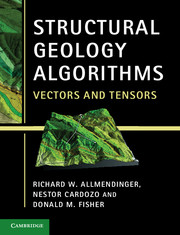Book contents
- Frontmatter
- Contents
- Preface
- Chapter One Problem solving in structural geology
- Chapter Two Coordinate systems, scalars, and vectors
- Chapter Three Transformations of coordinate axes and vectors
- Chapter Four Matrix operations and indicial notation
- Chapter Five Tensors
- Chapter Six Stress
- Chapter Seven Introduction to deformation
- Chapter Eight Infinitesimal strain
- Chapter Nine Finite strain
- Chapter Ten Progressive strain histories and kinematics
- Chapter Eleven Velocity description of deformation
- Chapter Twelve Error analysis
- References
- Index
Chapter Three - Transformations of coordinate axes and vectors
Published online by Cambridge University Press: 05 June 2012
- Frontmatter
- Contents
- Preface
- Chapter One Problem solving in structural geology
- Chapter Two Coordinate systems, scalars, and vectors
- Chapter Three Transformations of coordinate axes and vectors
- Chapter Four Matrix operations and indicial notation
- Chapter Five Tensors
- Chapter Six Stress
- Chapter Seven Introduction to deformation
- Chapter Eight Infinitesimal strain
- Chapter Nine Finite strain
- Chapter Ten Progressive strain histories and kinematics
- Chapter Eleven Velocity description of deformation
- Chapter Twelve Error analysis
- References
- Index
Summary
What are transformations and why are they important?
The word “transformation” looks imposing and mathematical but it is, in fact, quite a simple thing that we do commonly without thinking about it. Whenever we change coordinate systems, we do a coordinate transformation. Suppose we submit some samples of fossils and their locations in latitude, longitude, and elevation to a paleontologist for identification. The paleontologist writes back with the instructions that the locations in eastings and northings (i.e., UTM coordinates), not latitude and longitude, are required. Thus, a coordinate transformation is needed. This doesn’t make us very happy because the change requires a long calculation that would be tedious to do by hand! In this chapter, we are interested only in transformations that can be precisely described mathematically, but one should realize that coordinate transformations are a very common thing. Basically, coordinate transformations are just another way of looking at the same thing. In the above example, the specific numbers used to describe the location in the two coordinate systems are different but the physical location where the samples were collected has not changed. The change in numbers simply represents a change in the coordinate system not a change in the position or fundamental magnitude of the thing being described.
The concept of a transformation is very important and one with incredible power for a wide variety of structural applications. It is commonly necessary to look at a problem from two different points of view. For example, when studying continental drift (Fig. 3.1a), at least two different coordinate systems are commonly required, one in present-day geographic space and one attached to the continent at some time in the past when it was in a different place and orientation on the globe. Or, take the case of analysis of a fault (Fig. 3.1b). To understand what is going on from the perspective of the fault we need one coordinate system attached to the fault (e.g., with one axis perpendicular to the fault plane and another parallel to the slickensides on the fault). However, we also want to relate this to our more familiar geographic coordinate system; a transformation allows us to do that.
Information
- Type
- Chapter
- Information
- Structural Geology AlgorithmsVectors and Tensors, pp. 44 - 65Publisher: Cambridge University PressPrint publication year: 2011
